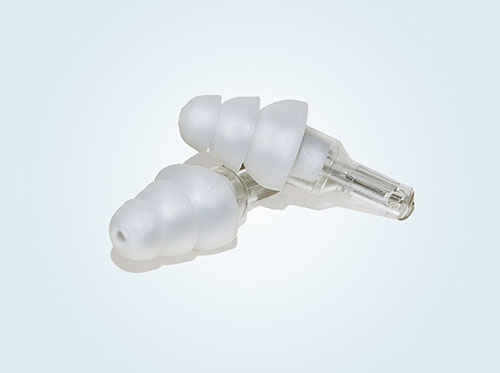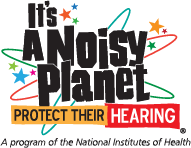The best way to protect your family’s hearing is to avoid loud sounds and noisy activities. The louder the sound, the more damage it can cause, and the faster the damage can happen. Hearing loss may not be noticeable at first, but it can get worse over time.
Turn down the volume on the TV and on music players, and move away from the noise, when possible. If loud noise can’t be avoided, have your family wear earplugs or protective earmuffs. Teach your children the importance of these habits to prevent permanent damage and to keep their hearing healthy.
When to Use Hearing Protectors
Teach your children to use hearing protectors during activities that are loud enough to damage their hearing over time. Examples of activities that are potentially loud enough to damage your hearing are:
- Attending movies, auto races, sporting events, fireworks shows, and music concerts.
- Riding a motorcycle, dirt bike, snowmobile, all-terrain vehicle, airplane, or tractor.
- Playing an instrument in a band.
- Participating in or attending shooting sports. A gunshot can be as loud as a jet engine at takeoff, which can damage your child’s hearing immediately and permanently.
How Sound is Measured
Sound is measured in decibels (dB). Sound at or above 85 A-weighted decibels (dBA) can cause hearing loss. The louder the sound, the faster it can damage your hearing. Very loud sounds can damage your hearing in less than 15 minutes.

Types of Hearing Protectors
The best hearing protection is the kind you’re most comfortable wearing because that’s the kind you’re most likely to use. Many kinds of hearing protectors are available both online and at grocery, drug, and hardware stores. Some kinds of hearing protectors are available in children’s sizes.
Not all hearing protectors provide the same amount of protection, and no hearing protector blocks all sounds. Check the noise reduction rating (NRR) of the earplugs or protective earmuffs to get an idea of how much protection they can provide when they are properly fitted and worn. The higher the NRR, the more noise they can block out. A higher NRR is not always better, however. If the NRR is too high or the protectors are not a good match for your specific environment or activity, you are more likely to remove your hearing protectors to communicate.
Earplugs
Earplugs fit directly into the ear canal, the narrow passageway between the outer ear and the middle ear. Earplugs are smaller and might be less expensive than earmuff hearing protectors. They come in disposable and reusable options, and some have handy cords that attach the two earplugs to help you keep track of them. Canal caps are a type of earplug that have a stiff band that provides a gentle force to seal the earplugs in the ear canal.
Earplugs come in various sizes, but some may be too big for kids to use. A parent should help especially young children insert earplugs, and make sure they are a good fit and the right choice of hearing protectors.
There are different kinds of earplugs:
Formable foam earplugs are typically made of soft foam, don’t cost much, and are available in many stores. Once inserted, these earplugs expand to fill the ear canal snugly.

Roll

Pull back and insert

Hold
How to use:
- Insert one earplug at a time. With clean hands, roll the earplug up into a small, thin “snake” with your fingers. To avoid making creases, which create tunnels that let in sound, start by using gentle pressure to roll the earplug and then gradually increase pressure.
- Pull the top of your ear up and back with your opposite hand to straighten your ear canal and make it easier to insert the earplug. Continue to roll the earplug before using the other hand to gently slide the earplug into your ear canal so that it is flush with the opening of your ear. You should not have to force the earplug in, and it should never hurt. If it does, remove the earplug and try again.
- Gently hold the earplug in place with your finger for 20 to 30 seconds to give it time to expand.
- Check the fit to make sure the earplug is comfortable and properly inserted. If it starts to expand out of your ear, it probably isn’t inserted correctly. If this happens, take the earplug out and try again. Have a buddy look and see if you have inserted the earplug properly, or use a mirror to check the fit.
- Note: For kids, it might be difficult to find foam earplugs that are small enough to fit all the way in the ear canal. Never try to cut the earplugs to make them fit, as this will decrease the effectiveness of the earplugs. If foam earplugs can’t be inserted properly, consider using protective earmuffs instead.
- Repeat these steps to insert a second earplug in your other ear.
- Voice check. When earplugs make a good seal, your voice should sound different to you, possibly louder and/or muffled.
- To remove the earplugs, slowly twist to break the seal with your ear canal and then gently take them out of your ear.
Pre-molded earplugs are made from plastic, rubber, or silicone. They are sold in different sizes, including sizes that fit children. One type of pre-molded earplug is uniform-attenuation, or high-fidelity earplugs. They have the same effect as turning down the volume on a stereo: The sound intensity is evenly decreased across different pitches—from the lowest (such as a bass drum) to the highest (such as a flute). You might find these helpful at movies and concerts, where you want to appreciate the audio quality and protect your hearing at the same time.
How to use:
- With clean hands, and clean earplugs, insert earplugs one at a time, one per ear. For each earplug, gently pull the top of your ear up and back with your opposite hand to straighten your ear canal. Use the other hand to firmly grip the stem of the earplug and gently slide the earplug into the ear canal, using a rocking motion until you have sealed the ear canal.
- Check the fit. You can make sure that the earplugs are fitted properly the same way you check formable foam earplugs: Ask a buddy to look, or use a mirror to see if the earplugs are inserted correctly. Your voice may also sound different to you.
- Carefully remove earplugs by slowly rocking them back and forth to break the seal with your ear canal. Then gently take them out of your ear.
- Earplugs should be cleaned between uses.
Earmuffs
Protective earmuffs are easy-to-use, padded plastic cups connected by a flexible headband. (They aren’t the soft earmuffs worn for warmth or fashion.) Protective earmuffs reduce noise by completely covering both ears and come in sizes that fit most people, including infants and children. Earmuffs are easier to use than earplugs, especially for young children.
Earmuffs might not work as well for people who wear glasses, which can create gaps between the earmuff cushion and the skull. If your child wears glasses, check to make sure the earmuffs seal properly and are comfortable. Certain hair styles or hats could also create gaps that make protective earmuffs less effective.
How to use:
- Grab each cup of the earmuffs, one side in each hand, and gently pull apart.
- Place the band over the top of your (or your child’s) head and slowly release the cups, making sure they completely cover the ears and aren’t too loose. Your voice should sound different to you if the earmuffs are fitted correctly.
Wearing earmuffs and earplugs together can further reduce sound, which is great for very noisy environments like woodshops and shooting sports events.

Formable foam earplugs

Pre-molded, high-fidelity earplugs

Canal caps

Protective earmuffs
Tips to Help Your Children Use Hearing Protectors
There are several apps that measure sound levels and indicate when sound levels may be hazardous for your hearing. For example, the National Institute for Occupational Safety and Health (NIOSH), part of the Centers for Disease Control and Prevention (CDC), developed the NIOSH Sound Level Meter (SLM) app found at https://www. cdc.gov/niosh/topics/noise/app.html for iOS devices to help identify sounds levels that may be harmful. You can download the free app at https://apps.apple.com/us/app/niosh-slm/id1096545820 on iTunes. Search for NIOSH SLM in the App store.
Just as you teach your children to wear sunscreen, a seatbelt, and a bicycle helmet, you can teach them how and when to wear hearing protectors.
- Set clear rules for when to wear hearing protectors. Tell your children that you expect them to wear hearing protectors in noisy areas, even when you aren’t there to supervise.
- Shop for hearing protectors with them. Discuss with your children whether they would rather wear earplugs that can be hidden by hair or a hat, or make a fashion statement with more noticeable hearing protectors. Many colorful and comfortable styles of hearing protectors are available in stores and online.
- Choose hearing protectors that fit with your children’s activities. Make sure the size and type of hearing protectors work for the environment where they’ll be used. Remember that if the hearing protector blocks out too much sound, your child might not be able to hear important warning sounds in his or her environment, or might take off the hearing protectors, risking hearing damage.
- Make sure hearing protection is within reach. Keep hearing protectors for your children in household areas where loud noises are common, but out-of-reach of small children and pets.
- Be a good role model. Children learn through observation and imitation. Set a good example: If you adopt healthy hearing habits, your kids might just do the same.
Caught Without Hearing Protectors?
If you forgot your hearing protectors at home or are suddenly confronted with a loud noise, cover your ears with your hands. Other ways to protect your hearing are to lower the volume (if possible) or to move away from the noise.
By teaching your children why, when, and how to use hearing protectors, you empower them to make healthy choices that can protect their hearing now and in the future.



